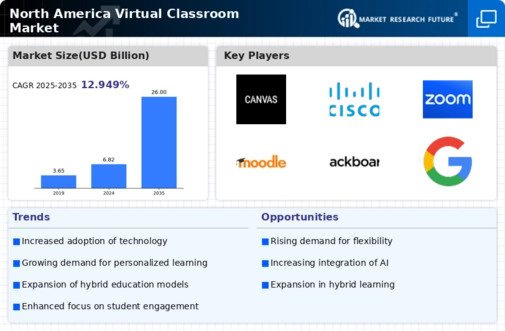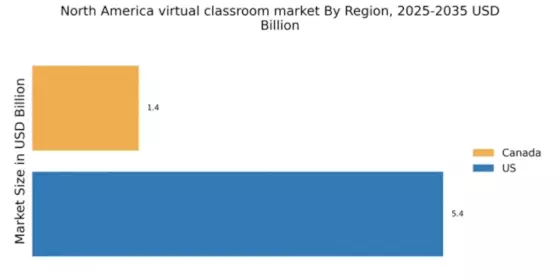Increased Investment in EdTech Solutions
The virtual classroom market is witnessing a significant increase in investment in educational technology (EdTech) solutions. North American educational institutions are allocating substantial budgets to enhance their digital infrastructure, aiming to provide high-quality virtual learning experiences. Recent statistics indicate that EdTech investments in North America reached approximately $10 billion in 2025, reflecting a growing recognition of the importance of technology in education. This influx of capital is likely to spur innovation within the virtual classroom market, leading to the development of more sophisticated tools and platforms that cater to the evolving needs of educators and learners alike.
Integration of Advanced Learning Analytics
The integration of advanced learning analytics into the virtual classroom market is transforming educational experiences across North America. Institutions are increasingly leveraging data analytics to monitor student performance, engagement levels, and learning outcomes. This data-driven approach enables educators to tailor their teaching strategies to meet individual learner needs effectively. Reports suggest that institutions utilizing learning analytics have observed a 20% improvement in student retention rates. As educational stakeholders recognize the value of data in enhancing learning experiences, the virtual classroom market is likely to witness accelerated growth, driven by the demand for analytics-driven solutions.
Rising Demand for Flexible Learning Solutions
The virtual classroom market in North America experiences a notable surge in demand for flexible learning solutions. This trend is driven by the increasing need for educational institutions and corporate training programs to accommodate diverse learning styles and schedules. As more learners seek the ability to access educational content at their convenience, the virtual classroom market adapts by offering asynchronous learning options. According to recent data, approximately 70% of learners express a preference for flexible learning environments, indicating a significant shift in educational paradigms. This demand for flexibility not only enhances learner engagement but also encourages institutions to invest in advanced virtual classroom technologies, thereby propelling market growth.
Expansion of Regulatory Support for Online Education
The virtual classroom market benefits from the expansion of regulatory support for online education in North America. Governments and educational bodies are increasingly recognizing the legitimacy and value of online learning, leading to the establishment of policies that promote its adoption. Recent legislative measures have provided funding and resources to support the development of online educational programs, thereby enhancing accessibility for diverse populations. This regulatory support is expected to bolster the virtual classroom market, as institutions are encouraged to innovate and expand their online offerings, ultimately contributing to a more inclusive educational landscape.
Growing Emphasis on Collaborative Learning Environments
The virtual classroom market is increasingly focusing on the creation of collaborative learning environments. As educational institutions recognize the importance of peer interaction in the learning process, they are adopting technologies that facilitate collaboration among students. Tools such as breakout rooms, discussion forums, and real-time collaboration features are becoming standard in virtual classrooms. This shift towards collaborative learning is supported by research indicating that students engaged in collaborative activities demonstrate improved critical thinking and problem-solving skills. Consequently, the demand for collaborative features within virtual classroom platforms is likely to drive market growth in North America.


















Leave a Comment